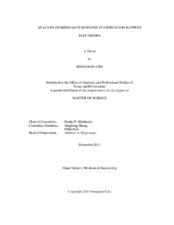| dc.description.abstract | A major amount of degradation in battery life is in the form of chemical degradation due to the formation of Solid Electrolyte Interface (SEI) which is a passive film resulting from chemical reaction. Mechanical degradation in the form of fracture formation due to diffusion induced stress can aggravate the aging of the electrode. These mechanisms of deterioration are primary contributors on limiting the durability of Lithium-ion battery (LIB). In addition, an composition of insertion materials such as active material, additive, and binder as well as active particle’s morphological heterogeneity can influence solid-state transport, electronic conductivity and hence, battery performance.
In this study, virtual 3-D microstructures of LIB electrodes with intercalation particles are designed to describe the influence of microstructure on effective electrical conductivity and the electrochemical impedance. The technique of digital stochastic modeling has been employed for the generation of electrode microstructures consisting of active material, binder, conductive additive and electrolyte. Physicochemical properties for each of the constituent phases have been duly accounted for. Mathematical models have been developed to characterize the electrochemical impedance of LIB electrode. In this work, we demonstrate the coupling of electrode microstructures to the solid state diffusion impedance response in LIB electrodes. This model considers not only the effect of heterogeneity in active particle size on the diffusion impedance response, but also the effect of electrical conductivity, interfacial surface area of the active materials, and volume fraction of the active materials in the porous electrode on the impedance response. In addition, the impact of the morphology of the active materials on the diffusion impedance response through utilization of the characteristic diffusion length of active particles and a Sauter mean particle size has been demonstrated.
In order to show the effect of chemical degradation on the impedance response with focus on aging, the Li-ion diffusion inside an active particle is considered along with SEI. Finally, mechanical degradation induced increase in impedance is analyzed by coupling diffusion induced fracture with impedance. These approaches are envisioned to offer a virtual impedance response probing framework to elucidate the influence of electrode microstructural variability and underlying electrochemical and transport interactions. | en |


